
The Interlaken Mill Bridge is an historic bridge spanning the Pawtuxet River at the site of the former Arkwright and Interlaken mill complexes in Coventry, Rhode Island. The lenticular pony truss bridge was built in 1885 by the Interlaken Corporation to provide a direct connection between the mill sites, having recently (1883) acquired the Arkwright property. The trusses were manufactured by the Berlin Iron Bridge Co. of Berlin, Connecticut. The bridge is a single span measuring 92 feet (28 m) in length and just under 19 feet (5.8 m) in width, resting on stone abutments.

The Atherton Bridge is a historic iron truss bridge in Lancaster, Massachusetts, spanning the South Branch of the Nashua River. It is a rare example of a hybrid pony truss that is similar to the 19th century truss design of Simeon S. Post. It was built by J. H. Cofrode & Co. of Philadelphia in 1870. It was the first iron bridge to be constructed in the town. The bridge was added to the National Register of Historic Places in 1979.

The Golden Hill Bridge is a historic bridge on Golden Hill Road over the Housatonic River in Lee, Massachusetts. It is a lenticular pony truss bridge built c. 1885 by the Berlin Iron Bridge Company, and is the state's oldest surviving bridge of this type. It is one of only five Berlin Co. bridges in the Berkshires, and is the only known surviving bridge to implement modifications to the pony truss design patented by William O. Douglas in 1885. The bridge was listed on the National Register of Historic Places in 1994.

The Glen Falls Bridge is a historic bridge that formerly carried Brunswick Avenue over the Moosup River in Plainfield, Connecticut. Built in 1886 by the Berlin Iron Bridge Company, it is one of a shrinking number of surviving 19th-century lenticular truss bridges in the state. The bridge was listed on the National Register of Historic Places in 1999. It has been closed to all traffic for many years.
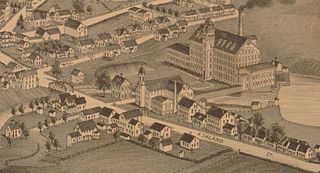
The Ashland Mill Bridge was a lenticular pony truss bridge over the Pachaug River in Griswold, Connecticut that was built in 1886 by the Berlin Iron Bridge Company. It was built following the Ashland dam break of February 1886 which washed away the previous bridges. The bridge served the millyard of the Ashland Cotton Company, in the Jewett City section of Griswold. The bridge was 65 feet (20 m) long and crossed a millrace on a skew angle. The Ashland Mill was damaged by arson in March 1995 and subsequently torn down, but the bridge itself remained. By 1999, the town deemed the bridge unsafe and closed it, and by February 1999, the bridge was moved to a vacant parking lot and was replaced with a new bridge. The bridge was added to the state of Connecticut historic register and it was later added to the National Register of Historic Places in April 1999. It was removed from the National Register in February 2016.

The Turn-of-River Bridge, also known as Old North Stamford Road Bridge, is a single-span lenticular pony truss bridge built by the Berlin Iron Bridge Company in 1892. It was listed on the National Register of Historic Places in 1987. It formerly brought the Old Stamford Road across the Rippowam River, but is now open only to pedestrian traffic, as the road ends shortly before the bridge.
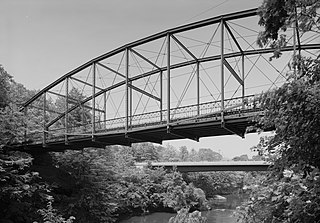
The Berlin Iron Bridge Company was a Berlin, Connecticut company that built iron bridges and buildings that were supported by iron. It is credited as the architect of numerous bridges and buildings now listed on the U.S. National Register of Historic Places. It eventually became part of the American Bridge Company.

The Main Street Bridge formerly carried Main Street over the Rippowam River just outside downtown Stamford, Connecticut. It was designed and manufactured by the Berlin Iron Bridge Company in 1888. It is a two-span wrought iron lenticular truss bridge, each span 60 feet (18 m) long, although there are supporting piers every 12 feet (3.7 m) feet. The abutments and central pier are cut granite and other stone, faced in concrete.

The Butts Bridge carries Butts Bridge Road over the Quinebaug River in the town of Canterbury, Connecticut. It is a well-preserved example of a Parker truss, built in 1937, late in the state's regular use of steel truss bridge designs. The bridge is also known as Bridge No. 1649 and carries an average of 2,300 vehicles per day as of 2011. It was listed on the National Register of Historic Places in 2010.

The Coon Creek Bridge is a historic bridge in rural western Benton County, Arkansas. The bridge carries County Road 24 across Coon Creek between Decatur and the Oklahoma state line. It is a single-span Warren pony truss bridge, with a span of 57 feet (17 m), that rests on concrete abutments. It was built in 1930 and underwent major rehabilitation in 1975.

Bridge 22, also known as the Creamery Bridge is a historic pony truss bridge, carrying Old Creamery Road across the Waits River in Bradford, Vermont. Built in 1934, it is well-preserved late example of a bridge style then passing out of fashion. It was listed on the National Register of Historic Places in 2010.

Marion County Bridge 0501F, also known as Indiana State Bridge 534-C-3439 on SR 100, is a historic truss bridge located on the Michigan Road at Indianapolis, Marion County, Indiana. It was built in 1941–1942, as a bridge along the State Road 100 project. It consists of two identical Warren pony truss sections at each end with two Parker through truss spans at the center. The pony truss sections are each 96 feet long and the through truss spans are 174 feet long.

The Foundry Bridge is a historic Warren pony truss bridge, carrying Foundry Road across the First Branch White River in Tunbridge, Vermont. Built in 1889, it is one of the state's oldest wrought iron bridges, and the only surviving example in the state of work by the Vermont Construction Company, its only local manufacturer of such bridges. It was listed on the National Register of Historic Places in 2007.
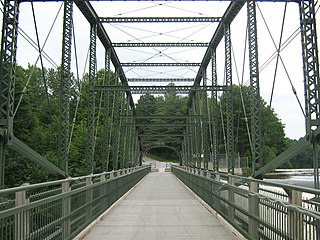
The Douglas & Jarvis Patent Parabolic Truss Iron Bridge is a historic bridge across the Missisquoi River in Highgate, Vermont. Located at the end of Mill Hill Road, it is at 215 feet (66 m) one of the longest bridges of its type in the northeastern United States. It was built in 1887, and was listed on the National Register of Historic Places in 1974.

The Old Boardman Bridge, formerly Boardman Bridge, is a historic lenticular truss bridge, which used to carry Boardman Road across the Housatonic River in New Milford, Connecticut. Built from 1887 to 1888 out of wrought iron, it is one of the state's three surviving examples of this bridge type, and along with Lover's Leap Bridge, one of two in New Milford. It was listed on the National Register of Historic Places in 1976. The bridge was closed to vehicles in 1984 and to pedestrians in 1985; however, the Town of New Milford is seeking to restore it and reopen it to pedestrian traffic.

The Minortown Road Bridge is a historic lenticular pony truss bridge in northeastern Woodbury, Connecticut. It spans the Nonewaug River, connecting U.S. Route 6 (US 6) to Minortown Road and Mill Road. Built in 1890 by the Berlin Iron Bridge Company, it is one a small number of surviving lenticular truss bridges in the state. It was listed on the National Register of Historic Places in 2001.
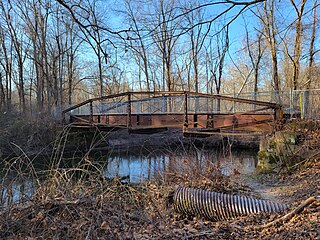
The Melrose Road Bridge is a historic bridge at the western end of Melrose Road in East Windsor, Connecticut. Built in 1888, it is one of a small number of surviving 19th-century lenticular pony truss bridges in the state. It was listed on the National Register of Historic Places in 1999. It was closed for many years, and lacked stringers and decking. In 2017, the town received an $85,000 state grant to add a new pedestrian deck between the historic trusses and to construct connecting trails.

The New Hampton Pony Pratt Truss Bridge is a historic pony Pratt truss bridge on Shoddy Mill Road in New Hampton of Lebanon Township, Hunterdon County, New Jersey. It crosses the Musconetcong River between Lebanon Township, Hunterdon County and Washington Township, Warren County. It was designed by Francis C. Lowthorp and built in 1868 by William Cowin of Lambertville, New Jersey. The bridge was added to the National Register of Historic Places on July 26, 1977 for its significance in engineering, industry and transportation. It is one of the few early examples of iron Pratt truss bridges remaining in the United States. It was later documented by the Historic American Engineering Record in 1991. It was added as a contributing property to the New Hampton Historic District on April 6, 1998.
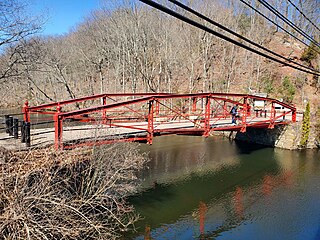
The Red Bridge is a historic bridge spanning the Quinnipiac River near Oregon Road in Meriden, Connecticut. It was built in 1891 by the Berlin Iron Bridge Company, and is one of a small number of surviving lenticular truss bridges in the state, and was listed on the National Register of Historic Places in 1993. The bridge is open to pedestrian traffic only.

The Washington Avenue Bridge is a historic lenticular truss bridge carrying Washington Avenue over the Mad River in Waterbury, Connecticut. Built in 1881, it is the oldest known surviving example of a lenticular pony truss bridge built by the Corrugated Metal Company, later known as the Berlin Iron Bridge Company, a prolific bridge maker in New England of the late 19th century. The bridge was listed on the National Register of Historic Places in 2001.






















